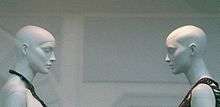Conceptual photography



Conceptual photography is a type of photography that illustrates an idea. There have been illustrative photographs made since the medium's invention, for example in the earliest staged photographs, such as Hippolyte Bayard's Self Portrait as a Drowned Man (1840). However, the term Conceptual Photography derives from Conceptual Art a movement of the late 1960s. Today the term is used to describe either a methodology or a genre.
Conceptual photography as a methodology
As a methodology conceptual photography is a type of photography that is staged to represent an idea. The 'concept' is both preconceived and, if successful, understandable in the completed image. It is most often seen in advertising and illustration where the picture may reiterate a headline or catchphrase that accompanies it. Photographic advertising and illustration commonly derive from Stock photography, which is often produced in response to current trends in image usage as determined by the research of picture agencies like Getty Images or Corbis. These photographs are therefore produced to visualize a predetermined concept. The advent of picture editing software like Adobe Photoshop has allowed the greater manipulation of images to seamlessly combine elements that previously it would only have been possible to combine in graphic illustration.
Conceptual photography as a genre
The term 'conceptual photography' used to describe a genre may refer to the use of photography in Conceptual Art or in contemporary art photography. In either case the term is not widely used or consistently applied.
Conceptual photography and conceptual art
Conceptual art of the late 1960s and early 1970s often involved photography to document performances, ephemeral sculpture or actions. The artists did not describe themselves as photographers, for example Edward Ruscha said "Photography's just a playground for me. I'm not a photographer at all."[1] These artists are sometimes referred to as conceptual photographers but those who used photography extensively such as John Hilliard and John Baldessari are more often described as photoconceptualists[2] or "artists using photography".
Conceptual photography and fine-art photography
Since the 1970s artists using photography like Cindy Sherman and latterly Thomas Ruff and Thomas Demand have been described as conceptual. Although their work does not generally resemble the lo-fi aesthetic of 1960s conceptual art they may use certain methods in common such as documenting performance (Sherman), typological or serial imagery (Ruff) or the restaging of events (Demand). In fact the indebtedness to these and other approaches from Conceptual Art is so widespread in contemporary Fine-art photography that almost any work might be described as conceptual. The term has perhaps been used most specifically in a negative sense to distinguish some contemporary art photography from documentary photography or Photojournalism. This distinction has been made in the coverage of the Deutsche Börse Photography Prize.[3]
Conceptual photography in the modern-day world
With software such as Adobe Photoshop publicly available all over the world, more and more photographers have been willing to give conceptual photography a go as photo manipulation software has advanced. The popular image sharing website Flickr is a haven of examples of conceptual photography. Artists such as Aaron Nace and Rosie Hardy have gathered great exposure through this site. The most famous story being when Rosie was commissioned by Maroon 5 to create a piece of conceptual photography to use as their cover for the album, Hands All Over.
References
- ↑ A.D. Coleman (10 September, 1972), "I'm Not Really A Photographer", The New York Times.
- ↑ Melanie Marino, Disposable Matter: Photoconceptual Magazine Work of the 1960s, in The Last Picture Show - Artists using photography 1960–1982, Douglas Fogle, 2003
- ↑ Sean O'Hagan, (16 November 2009), Why conceptual photography is having a prized moment The Guardian
External links
- What is Conceptual Photography? – themed films at Source Magazine
- Conceptual Art and Photography – Article at The Metropolitan Museum of Art
- What is Conceptual Photography? – Article at Wisegeek